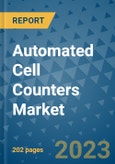The global automated cell counters market is poised for remarkable growth, from USD 6.9 Billion in 2024 to USD 9.9 Billion by 2031. Several key drivers are propelling this growth, transforming the landscape of cell counting in laboratory and clinical settings.
This product will be delivered within 1-3 business days.
Key Drivers of Market Growth
- Increasing Prevalence of Chronic and Infectious Diseases: The global rise in chronic and infectious diseases such as cancer, AIDS, sepsis, malaria, influenza, and others is a pivotal factor driving the growth of the automated cell counters market. The necessity for precise cell counting in the diagnosis and treatment of these life-threatening diseases is boosting market demand.
- Scientific and Technological Advancements: The integration of Big Data technologies and medical image analysis software is revolutionizing cell-based research, driving the demand for automated cell counters. These advancements are enhancing disease identification, reducing patient costs, and improving treatment quality, bolstering market growth.
- Increased Government and Corporate Funding: Significant investments by governments and corporations in healthcare sectors are facilitating the adoption of advanced technologies. This influx of funding is creating substantial opportunities for the automated cell counters market, benefitting research centers, educational institutes, hospitals, and medical establishments.
Challenges and Limitations
- High Costs, Scarcity of Skilled Professionals, and Poor Healthcare Infrastructure: The high expenses associated with cell counting procedures, equipment, and apparatus deter investment in medical and research applications. Inadequate healthcare infrastructure in impoverished nations, along with a shortage of trained specialists, poses challenges to market expansion.
COVID-19 Impact
The COVID-19 pandemic had a significant impact on the automated cell counters market. The heightened importance of cell count analysis in COVID-19 patients, particularly in identifying eosinopenia and lymphopenia as potential indicators, led to increased utilization of automated cell counting devices during the pandemic. This trend is expected to persist and continue driving market growth in the post-pandemic era.Competitive Landscape
The automated cell counters market is moderately competitive, with major players implementing innovative strategies to fulfill product demand and expand their global presence. Companies are focusing on research and development, post-sales and service agreements, partnerships, mergers, and acquisitions to dominate regional markets and cater to evolving customer needs.Key Companies in the Market
- Danaher Corporation
- Biotek Instruments, Inc.
- Alere Inc.
- Bio-Rad Laboratories, Inc.
- F. Hoffmann-La Roche Ltd
- ChemoMetec A/S
- Logos Biosystems
- Beckman Coulter, Inc.
- NanoEnTek Inc.
- Olympus Corporation
Automated Cell Counters Market Segmentation
Automated Cell Counters Market by Product
- Systems Type
- Reagents & Consumables
Automated Cell Counters Market by Application
- Blood Analysis
- Urine Analysis
- Microbial Cell Count
- Cell Line Viability
- Others
Automated Cell Counters Market by Region
- North America
- Latin America
- Europe
- Asia Pacific
- Middle East & Africa (MEA)
This product will be delivered within 1-3 business days.
Table of Contents
1. Executive Summary
2. Market Overview
3. Global Automated Cell Counters Market Outlook, 2018 - 2031
4. North America Automated Cell Counters Market Outlook, 2018 - 2031
5. Europe Automated Cell Counters Market Outlook, 2018 - 2031
6. Asia Pacific Automated Cell Counters Market Outlook, 2018 - 2031
7. Latin America Automated Cell Counters Market Outlook, 2018 - 2031
8. Middle East & Africa Automated Cell Counters Market Outlook, 2018 - 2031
9. Competitive Landscape
10. Appendix
Companies Mentioned
- Danaher Corporation
- Biotek Instruments, Inc.
- Alere Inc.
- Bio-Rad Laboratories, Inc.
- F. Hoffmann-La Roche Ltd
- ChemoMetec A/S
- Logos Biosystems
- Beckman Coulter, Inc.
- NanoEnTek Inc.
- Olympus Corporation
Methodology

LOADING...








